![]() 1st Battalion 22nd Infantry
1st Battalion 22nd Infantry ![]()
SGT Terry Kotschwar
Memories of a Cold War Warrior
Part Two
|
Training aid, dated 1 Jan 1975 |
|
The Green Chip Award Given by the Commanding General |
I got my first Green Chip Award
in 1979 after passing the IG Inspection for the final time. I
think I should have got it the first time
when I was up for three days the day after graduation from TAMMS
(The Army Maintenance Management System) School.
I passed that inspection and I will tell you, they didn't have a
prayer before I redid their books. I still have it from the
CG...Job Well Done.
My commanders weren't really big
on awards, promotions or acknowledgements. I know that Lt. Lee
was supposed to put me
and Kenny Davidshofer in for an Arcom, but he drug it out and we
never got it.
We had a unit lose 11 men (not
sure of the actual number, but I was thinking it was everyone on
board) in a track that plunged down a ravine
killing everyone on board. They sealed the vehicle up and
wouldn't let anyone look inside it. That is one reason I turned
on my lights
when I lost contact with the vehicle ahead of me during a
tactical operation while driving an APC. It was nighttime, the
dust and dirt was like
that on the moon when in the summer months. You occasionally lose
sight of that little 3/8 wide by 4' red tail light on the APC in
front of you
at night. I told the TC that I couldn't see and pulled up. I told
him that I remeber the spot we were in and that there was a drop
off
near where we were. I told him I had to turn on the lights to
see. I ok'd it and I turned them on. We were one vehicle width
off the path
and directly next to the drop off. I was glad and so was the TC.
We didn't tell the others because we didn't want them to worry,
but it was hazardous all the same, even in peace time. We lost a
lot of people in a peacetime Army that never were given
recognition for their contributions.
We were in the new barracks at
the North End of Fort Carson. It was across the street from the
Battalion and the Chapel.
It was down the street from the PT field and next to 1st Bn 11th
Infantry. We bartered with 1/11 and on rare occasions used some
of their equipment,
mechanics and supplies to complete our missions. You either
worked together or suffered the consequences. We had a really
good system.
I felt like Radar O'Reilly sometimes in that I had to utilize the
"network" (we refused to call it the Black Market) to
get what we wanted.
I am not sure that the officers ever knew about the network, but
they had to. I think they just felt if it wasn't broken don't fix
it and allowed us
to work our magic. Anyway, we had most of the post on the net
through various people knowing certain people, etc. We didn't
have PC's,
computers to keep all our items recorded or to search the
internet like today. We had a FISH. A microfische system for
which I would get
new sheets of part numbers that had NSNs (National Stock Numbers)
on them so I could order parts. One month you might find
that the differential or some other part you needed was no longer
an order item, but it was essential to keeping your vehicles in
working order,
so you had to adapt and overcome the problem situation. We always
overcame any obstacle, because we were good at scrounging
or modifying one item to fit another vehicle. Sometimes they
weren't made for that vehicle, but the mechanics would
"adapt" them to make them workable.
We had a dedicated group of
people to work with. I remember we had a track (APC) go down in
the field and we used the M578
to pull the pack. Davidshofer, Rudy, Swink or Hansen worked on it
all through the night. It was a mess. We didn't have power tools
so everything was hand tools and makeshift lighting. We got the
pack pulled, repaired and put in by breakfast. The only thing we
had to do
was put the fluids in and test it. I cranked it up and it
hyperventillated. The blower was stuck wide open and it was
maxing out on revolutions
and the kill switch wasn't working. At first they would yell
"runaway" indicating that the engine was out of control
and could possibly tear itself apart.
It usually meant that we had to leave the area. Swink watched the
damn thing for a mintue or two and it didn't explode, stop or
change pitch.
It was deafening hurting your ears and just whining like a dying
beast trying to escape. Swink grabbed a seat cushion from
somewhere
and put it over the air intake and it finally choked out and
quit. Not sure what the problem was but we couldn't shut it off
inside the track
and the linkage was stuck open. Swink was never one that showed
much emotion and he (like most of the mechanics) could fix
anything.
He was stationed in Korea prior to coming to our company and
perhaps he just had the real life knowledge that we youngsters
just didn't have yet.
We fixed the problem and got the track back into service. One of
many daily tasks that go unseen except by those who do the work
and just keep things running. Results are what are noticed, not
how they come about. We constantly gave positive results and
people just left us alone
to do our work because it wasn't broken.
Track pads came in large crates
when you could get them. They were not really a critical red line
item, but were required for a track
to make it to 100% compliance. We traded, bartered and litteraly
swiped pads for vehicles to at least meet the percentage required
for compliance.
You had to have so many percent of "good" pads on the
vehicle to make it acceptable. I remember calculating the number
of pads required
to make all my vehicles pass inspections and then took good pads
off new tracks to make older ones pass inspection. It was a
balancing act
all the time. I kept track of my expenditures and never broke the
bank buying more than I was allocated and I was always able to
keep my vehicles working.
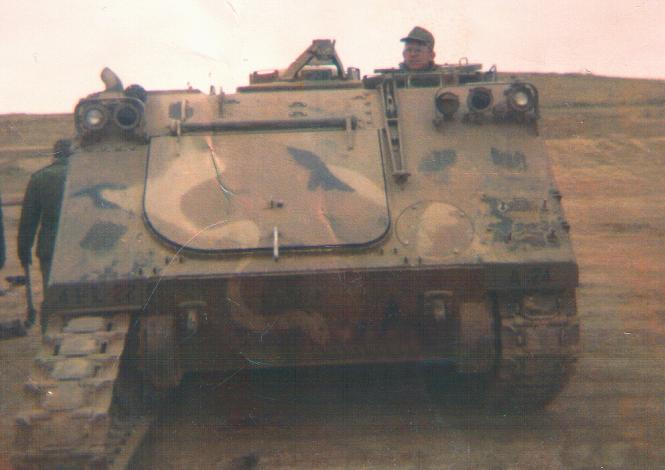
M113 APC of Company A 1/22 Infantry
(Track No. A-24)
Driver is Terry Kotschwar
The trim vane is missing off
this track (A-24) because I think (and I know it doesn't look
like it) that the track was just painted again.
Most of the imperfections were from the damage to the photograph
I think. The pads that would have been located at the bottom
front edge
were taken off to add to the right side track. I always scrounged
two new pads just in case. If I remember right, between each
section of track
is a log rod or pin that has a locking nut attached to the
inside. You locked the tread or track on the opposite side using
a pair of latterals
which were long aluminum shafts which had a push button at the
top. Your could push the button on the anchor or non-repaired
side of the vehicle
and then, after you removed one pin between two sections of
track, you could get the track sections to move forward or
backwards
on the final drives or the cogged wheels at the front of the
track. The sections were extremely heavy and inveriably they
would not fit together easily
and usually had to be coherced with a sledge hammer, tanker bar
or some other tool to make it willing to cooperate and fit
together.
Surrounding the pin that went through the track section was a
rubber bushing that always wore out and was the primary reason
for replacing a track section.
You always inspected your track spacing with a metal gauge that
went from the center line of one pin to the center line of the
second pin.
If your spacing between the two was excessive it could lead to
failure and that could be disasterous when hurling a vehicle that
weighed
about 11-tons along a tank path to have it suddenly throw a
track. Not Good.
The main problem is that you
needed to have a certain number of track sections out of
tollerance in order to warrant a work order
to have replacement sections ordered by Battalion or they
wouldn't send in an order. The order could take over a month to
fill and that means
a red-lined (useless or dangerous) track. You anticipated needing
sections and "adjusted" your count to allow enough time
for your repair parts
to come in before you actually really needed them. There was
ALWAYS a flurry of requests prior to IG Inspection time which
upsets
the Supply/Demand balance making for some very unhappy people.
Experience taught you to order "off season" and store
it until
you actually needed them and a week or so prior to the IG you had
a track breaking party and all the drivers, TC's and crews
were on the hill side breaking track. Having little use on a set
of new treads helped IG inspectors pass your vehicles and made it
hard for them
to want to look for failure items. Another thing learned from
experience. Never tick off the IG. They have the power, time and
need
to find something wrong with a vehicle if you make them mad. You
always have hot coffee and donuts and a clean desk and chair for
them to sit in.
Never hurts to plan ahead. I never failed a single IG inspection.
Battalion was the only unit that
had a steam cleaner and you paid dearly to get to use it, but it
was the only way to get Petroleum,
Oil and Lubricants (POL) out of the engine and interior
compartments of a tracked vehicle. You removed everything inside
the track.
All the paperwork, tools, seat pads and anything else that you
didn't want to soak. You put on an old set of fatigues, boots and
then took
the bottom plates off the track and then steam cleaned
everything. It took a long time to do and every member of the
crew was involved
(except the slackers) to get your track ready for inspection.
Keeping in mind that everyone wanted the steam cleaner, the
bidding got pretty steep,
but if you knew where some of the bodies were buried, you moved
up the ladder pretty fast. We had lots of body maps, so to
speak...just kidding!
A broken trim vane was a dead
line item. Not that we ever put one in a lake or were ever going
to plan to, they would surely deadline a track
like no other item except a neutral safety switch or ramp cable.
The trim vane was only a piece of plywood but should you ever
want to float an APC
you need a trim vane to get into the water, otherwise the wake of
water would over take the track, fill it up and send it to the
bottom
like a bucket of mud. Every once in a while a driver thought he
was driving a M-60A2 tank and try to knock over a cedar tree that
grew everywhere
down range at Carson. They always broke the damn trim vane and
you could get a replacement (maybe) but it always had to be
painted
the tri-camoflage color. It was always sent in dark green from
704th and wasn't acceptable for inspection. The drivers usually
took the trim vanes
off the track in anticipation but always lost the nuts, bolts and
screws for the new one, which had to be ordered individually.
There were a lot of parts to keep track of and usually they
failed to keep the original parts or damaged them while taking
them apart.
We had to keep a specific nut, bolt or washer for that purpose
because inspectors loved to gig you on having the wrong parts on
a vehicle.
I had extras. I kept neutral safety switches in my desk drawer
and the mechanics knew not to let a crew memeber put them in
because
they always burnt them up somehow. Without the switch the engine
wouldn't start and that prompted crew members to become creative
in bypassing the wiring to make the engine start. Mechanics were
not very tollerant with people "Modifying" standard
wiring, unless of course,
they did the modifications.
Sergeants run the Army, but Mechanics get you to where you need to go...
|
Kenneth John Davidshofer Company A 1/22 Infantry "Without Kenny, I would not have
been nearly as efficient, as we were as a unit. Terry Kotschwar - 2010 |
Below:
The rather gruesome illustration on
this training aid is a reminder of the ever-present reality
that Soldiers of 1/22 Infantry had to live with during the 1970's
and 1980's. Nuclear war was a very real
possibility during those years, and 1st Battalion consistently
trained in preparation for it.
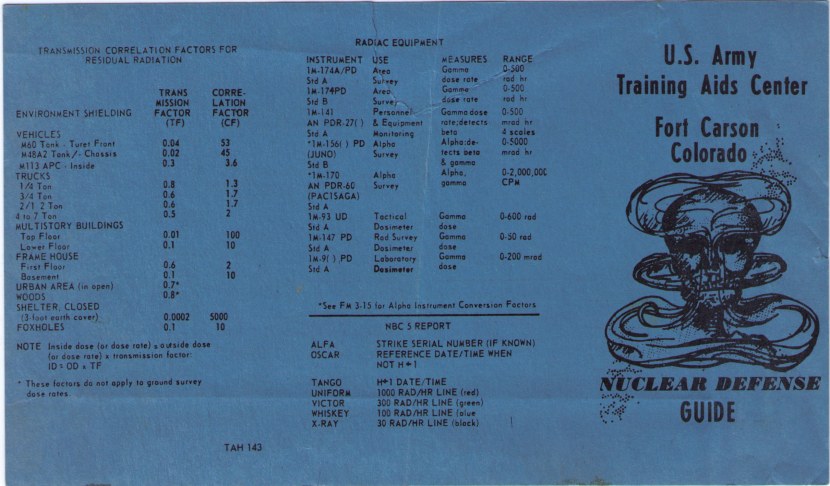
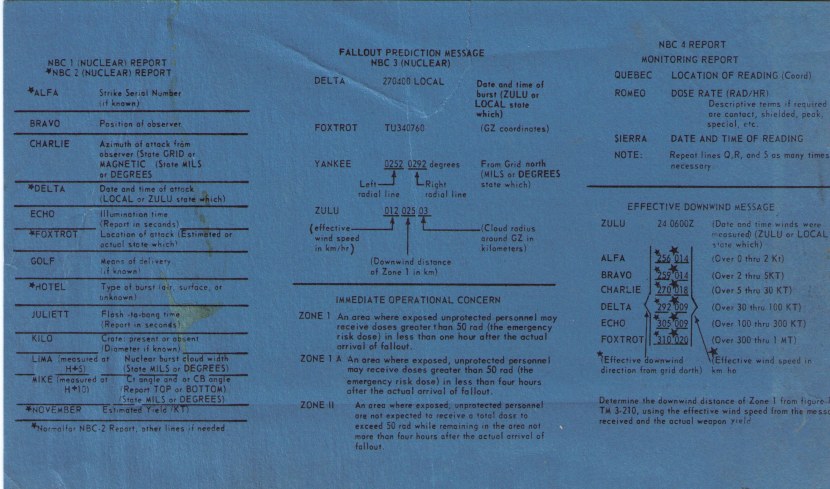
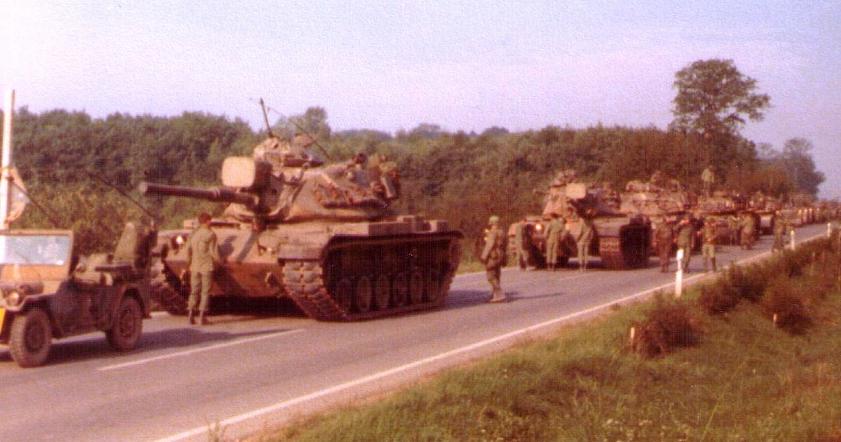
Formation of M-60 tanks in Germany,
during Reforger '77.
List of all the vehicles in Company A 1/22 Infantry "Don't ask me why I documented
this information, but I always liked stats. Terry Kotschwar - 2010 |
|
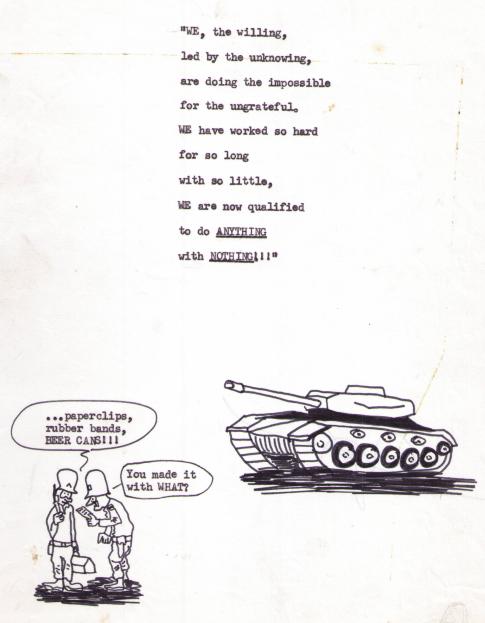
Sign posted in the motor pool of Company A 1/22 Infantry
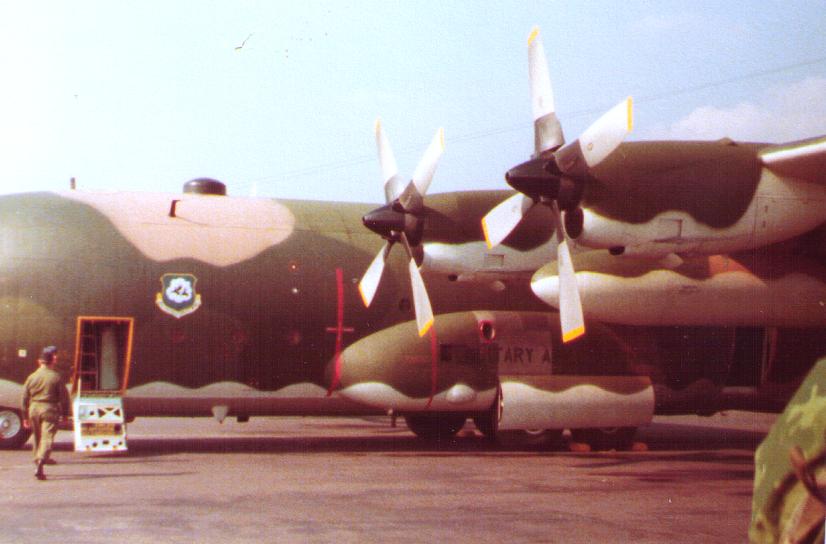
C-130 Hercules transport at "Pete
Field" 1977.
C-130's and C-141's were the main aircraft used by 1/22 Infantry
during the many times they were place on alert while at Fort
Carson.
All photos courtesy of Terry Kotschwar
Home | Photos | Battles & History | Current |
Rosters & Reports | Medal of Honor | Killed
in Action |
Personnel Locator | Commanders | Station
List | Campaigns |
Honors | Insignia & Memorabilia | 4-42
Artillery | Taps |
What's New | Editorial | Links |